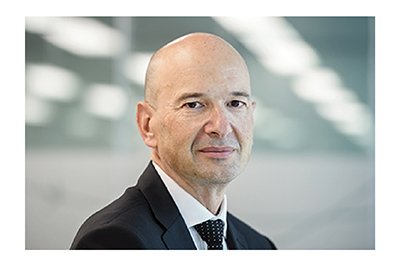23 December 2021
Interview with...Ivan Bassato
Head of Business Unit Aviation, Aeroporti di Roma.
[Cleared n°10 - Year XIII - November_December 2021]

Volocopter will be among the first to make commercial, flying-taxi services a business reality: a quiet, ecological vehicle that will connect the airport with the centre of Rome in 15 minutes. In your opinion, what is the outlook for vertical air mobility in Italy?
Over the next few years, we estimate that traffic in city centres all over the world will be at gridlock. Urban air mobility in this context will be part of the solution as a completely new mobility service, offering people and goods a form of air transport that is battery-powered and thus totally emission-free. Together with the authorities and Italian regulatory bodies and with the full support of Atlantia, Aeroporti di Roma and Volocopter, we will raise the awareness of passengers and public opinion on the advantages of UAM, opening the way to bringing it to Italy within the next 3 years. According to our forecasts, towards the end of 2024, these innovative means of transport will be taking off from the roof of one of the car parks at Fiumicino airport to reach the city of Rome. But there are also other routes under examination that might also lead Volocopter in the future to land on the roofs of a few large buildings in the city. And in this sense, Rome will be one of the first major cities in Europe to try out this innovative method of transport and the first in Italy. So, we are confident that this kind of experiment will, in the near future, be exported to other major cities in Europe as well as to other European airports.
How does the use of electric ADR air helicopter taxis such as Volocopter’s “Volocity” service fit into the wider intermodal development plans for Rome-Fiumicino?
The development of access infrastructures to Rome’s “Leonardo da Vinci” airport is one of the most important objectives for Aeroporti di Roma. The creation of a system capable of speeding up access to the airport must be seen as an absolutely essential condition for the airport’s own development. And it is within this context that the “Volocity to Rome” plan finds its collocation. The new service will be able to link the “Leonardo da Vinci” international hub with various locations in Rome via vertical airports known as ‘vertiports’ which will be built at the airport and various strategic points in Rome, such as the city centre. With this innovative method of transport, passengers will be transferred to the centre of the Capital in just 15 minutes. Booking the service will also be a simple matter, using a smartphone app that is incorporated with the other surface mobility services. All this will provide enormous, time-saving benefits for users who currently use the other traditional methods of transport to reach the city centre from the airport.
ADR, Enac and ENAV are playing a major role in trying to bring a highly sustainable solution into the field of aviation: will the recourse to battery-powered electric air-taxis, which are therefore emission-free, be part of the solution for highly congested city centres all over the world?
Absolutely. This will allow quality trips in full comfort, considerably reducing traffic congestion and CO2 emissions, since the 18 motors of VoloCity are fully electric of the BLDC (Brushless DC) electric motor type which enable a totally sustainable form of travel, with absolutely no emissions.
For the fourth year running, Rome Fiumicino airport has been acknowledged as the “Best Airport” by ACI (Airport Council International), by measuring the quality perceived in 350 airports all over the world. How did your organisation address the COVID 19 pandemic and with what tools?
Right from the start of the pandemic, ADR implemented in record time all the protocols and safety measures established by the health authorities and, in many cases, launched additional supplementary initiatives for passenger safety. In short, Fiumicino is a functional and, above all, safe airport. The measures are organised along the 2 fronts of protection and defence, guaranteed by the sanitisation of all airport spaces six times a day, covering all spaces and surfaces of the terminal. In addition, automatic “UV Clean Touch” sanitisation systems have been implemented on all escalators and lifts. Over 100 automatic temperature scanners measure the temperatures of passengers and airport staff in less than 2 seconds. There are also over 350 sanitising gel dispensers, signs that establish social distancing and totems and digital monitors to inform passengers about the anti-Covid measures to be adopted. The most recent measure involves the new automatic sanitisation system for passenger item holders using a machine that can sterilise the holders in about 10 seconds, reducing viral and bacterial load by 95%. All these measures, applied with the utmost rigour, gained Fiumicino Airport an important recognition from the ACI (Airports Council International) – an international organisation that measures the quality of services in airports all over the world – making it the best airport in Europe for the fourth year running. Not least, I would like to remember the other awards received for the anti-Covid measures applied at the airport, such as Rina’s Biosafety Trust Certification and ACI’s Airport Health Accreditation. In addition, as the world’s leading airport, Fiumicino attained the maximum 5-star rating from Skytrax, the international organisation that assesses airlines and airports all over the world.


